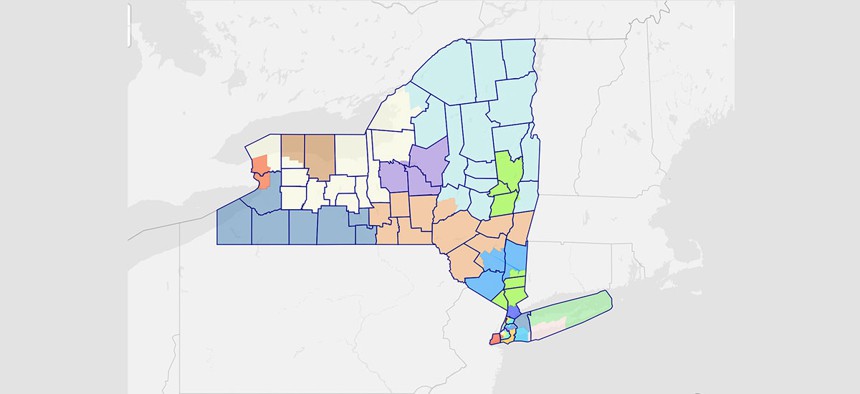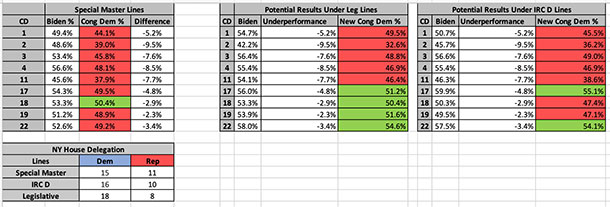Politics
Don’t blame the maps: analysis suggests different districts wouldn’t have helped Dems much
State Sen. Michael Gianaris doesn’t regret going hard on the maps

Congressional map of New York via Dave's Redistricting Jeff Coltin
There’s more than enough blame to go around, after New York Democrats’ uniquely weak performance in the Congressional midterm elections. Among those taking heat: state Sen. Michael Gianaris, who oversaw the process that got Congressional maps favorable to Democrats thrown out, and replaced with less friendly ones drawn by a special master.
But a preliminary analysis of the results shows that the special master’s district maps probably did not play as much of a role in Democrats’ losses as some have assumed. The party may have held just one more seat if state legislators and the governor had settled for a less partisan map. And results were so poor for Democrats this year that even the Legislature’s aggressive lines wouldn’t have been a cure-all. Dems would have likely won just four out of the nine competitive seats – still losing all of Long Island.
“The data makes clear that the problem on Election Day was a performance issue, not a district issue,” Gianaris, the deputy majority leader, told City & State after reviewing the analysis. “Under any alternative scenario of district lines, you’d have substantially the same results.”

Analysis obtained by City & State presents the preliminary election night results in nine House races, and looks at how much the Democrat underperformed President Joe Biden’s 2020 performance within the same district lines. Under the special master maps – the ones currently in use – Democrats won just one of the nine competitive races, with Rep. Pat Ryan, in the 18th Congressional District in the Hudson Valley. (The 22nd Congressional District in Central New York has been finalized yet, but Republican Brandon Williams is expected to win.)
If Gianaris and Albany Democrats had instead settled for more competitive Congressional lines, they might have looked like the plan submitted by the Democratic commissioners on the Independent Redistricting Commission. If you extrapolate how much the Democratic nominees underperformed Biden to those district lines, the party might have won two of the nine competitive seats: the 17th Congressional District and the 22nd.
And if the courts had just accepted the deep blue maps that the Legislature passed and Hochul signed into law? Democratic candidates might have won in the 17th, 18th and 19th Congressional districts in the Hudson Valley as well as the 22nd. But even gerrymandering probably wouldn’t have been enough to save Long Island. Republicans still likely would have won the 1st, 2nd, 3rd and 4th Congressional Districts, as well as the 11th Congressional District on Staten Island and Brooklyn. Yes, even Park Slope might not have been able to save Max Rose this year (Though The City’s separate analysis suggests he could have won a narrow victory under that scenario.)
Some caveats are needed. First, statewide electoral district level data is not available yet, and likely will not be for weeks. For now, we need to rely on rough math, rather than specific results of which party people voted for.
Second, it’s impossible to know what factors might have changed if different district lines were in place. For just one example, Rep. Sean Patrick Maloney might have run in the 18th, rather than the 17th, which could have changed the dynamics, the strategy, the turnout, and ultimately could have changed the results. The analysis only offers insight based on voting patterns that exist because of the districts as they were drawn.
Third, this is just one election cycle, and these maps will probably be in place for four more.
And fourth: the balance of power in the House is so thin that every single race may count. Even if the districting debacle resulted in the Democrats losing just one extra seat in New York, that one seat may end up being incredibly consequential.
And that’s part of why Gianaris is so adamant that he shouldn’t be blamed for trying to draw a map that was as favorable to Democrats as possible.
“This is the problem with the Democratic Party in New York State. The conclusion that they have reached is that we should have tried less. We should have appeased our opponents. We should have intentionally built a less Democratic map,” he said. “Which would still land you in the situation we are today. That kind of weak approach typifies why we have the problems that we do.”
Publicly, Democrats – particularly progressives – have laid the bulk of the blame at the feet of state Democratic Party Chair Jay Jacobs, Democratic Congressional Campaign Committee Chair Rep. Sean Patrick Maloney and former Gov. Andrew Cuomo, who negotiated the flawed redistricting process a decade ago. Gov. Kathy Hochul’s campaign has also received post mortems expounding on its flaws. But Gianaris, who co-led the redistricting process for the Legislature, has found himself on the receiving end of criticism as well. “Kevin McCarthy is going to be the speaker of the House, and he should send Mike Gianaris flowers. A bouquet,” said one operative at the post-election Somos conference in Puerto Rico. “People who led the redistricting effort should understand that they didn’t follow the rule of the law, and Michael Gianaris, who led the process, is to blame,” former New York City Council Member Elizabeth Crowley told the Daily News.
In the wake of New York’s congressional red wave, editorial boards were also blunt about Gianaris’ share of blame for Democrats’ spectacular losses. The Daily News called Gianaris’ maps tossed for gerrymandering a “greedy, unconstitutional overreach.” The New York Post dubbed Gianaris “universally seen as the prime mover of New York Dems’ disastrous redistricting debacle,” suggesting that Democrats should aim their ire at him.
Gianaris has quickly and fiercely defended himself since lawmakers first released their congressional maps, and that has continued post election. Now, his defense has gotten a boost. “The critics appear to be those that have a self-interested agenda or are speaking from ignorance,” Gianaris siad. “Any steps back from the maps that we actually passed wouldn’t have yielded substantially different results.”
Gianaris has long used as a defense the flawed redistricting process approved in 2014 under Cuomo and a Republican state Senate. Redistricting expert and New York Law School Professor Jeffrey Wice agreed with Gianaris to an extent. “The redistricting process was designed by Andrew Cuomo and Senate Republicans and was designed to fail,” Wice told City & State. “The fault lies more with the process than with the maps.” Although he has not performed his own post-election analysis of what might have happened with different district lines, Wice said that if the analysis obtained by City & State is accurate, it “goes to show the boogeyman isn‘t the Democratic map that was rejected.”
Cuomo World disagreed with Gianaris and Wice’s framing, leaving out the role of the Democratic-led Assembly, as well as voters.
“Let’s make sure the facts are crystal clear: the constitutional amendment was an agreement with the governor, the Senate and the Democratic Assembly, which not only passed it twice but passed it with 90% of the vote, and then it was overwhelmingly approved by New Yorkers,” said Rich Azzopardi, a spokesperson for Cuomo, in a statement sent after this article was initially published. “If Albany pols are looking for someone to blame for this debacle, there are plenty of mirrors in this town.”
Gianaris has also pointed to the fact that the congressional lines were thrown out over procedure in addition to gerrymandering, effectively making the alleged partisan drawing moot. But a mid-level state court that called the legislative procedure appropriate also upheld the original ruling on unconstitutional gerrymandering, suggesting that the lines drawn by lawmakers may have been doomed to fail even if the Legislature went about their task differently.
Still, the new analysis helps give credence to Gianaris’ assertion that he is not to blame for Democrats’ losses in New York, and potentially the party’s loss of the House. And others, for one, seem inclined to agree with him. “Dems lost *five* NY seats that voted for Biden by more than the national result in ‘20 - including two that voted for Biden by double digits,” Cook Political Report’s David Wasserman said in a tweet Sunday. “You can’t really blame that on bad redistricting.”
Editor's note: This story was updated to include comment from former Gov. Andrew Cuomo’s spokesperson.
